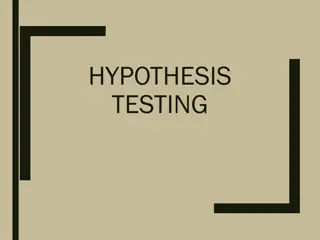Understanding Type I and Type II Errors in Hypothesis Testing
In statistics, Type I error is a false positive conclusion, while Type II error is a false negative conclusion. Type I error occurs when the null hypothesis is incorrectly rejected, leading to a conclusion that results are statistically significant when they are not. On the other hand, Type II error happens when the null hypothesis is not rejected when it should have been. These errors can be minimized through careful study design and understanding of significance levels and statistical power.
Download Presentation

Please find below an Image/Link to download the presentation.
The content on the website is provided AS IS for your information and personal use only. It may not be sold, licensed, or shared on other websites without obtaining consent from the author. Download presentation by click this link. If you encounter any issues during the download, it is possible that the publisher has removed the file from their server.
E N D
Presentation Transcript
In statistics, a Type I error is a false positive conclusion, while a Type II error is a false negative conclusion. The probability of making a Type I error is the significance level, or alpha ( ), while the probability of making a Type II error is beta ( ). These risks can be minimized through careful planning in your study design. TYPE I AND TYPE II ERRORS Example: You decide to get tested for COVID-19 based on mild symptoms. There are two errors that could potentially occur: Type I error (false positive): the test result says you have coronavirus, but you actually don t. Type II error (false negative): the test result says you don t have coronavirus, but you actually do.
TYPE I AND TYPE II ERRORS CONT..
TYPE I AND TYPE II ERRORS CONT..
TYPE I ERROR A Type I error means rejecting the null hypothesis when it s actually true. It means concluding that results are statistically significant when, in reality, they came about purely by chance or because of unrelated factors. The risk of committing this error is the significance level (alpha or ) you choose. That s a value that you set at the beginning of your study to assess the statistical probability of obtaining your results (p value). The significance level is usually set at 0.05 or 5%. This means that your results only have a 5% chance of occurring, or less, if the null hypothesis is actually true. If the p value of your test is lower than the significance level, it means your results are statistically significant and consistent with the alternative hypothesis. If your p value is higher than the significance level, then your results are considered statistically non-significant.
TYPE II ERROR A Type II error means not rejecting the null hypothesis when it s actually false. This is not quite the same as accepting the null hypothesis, because hypothesis testing can only tell you whether to reject the null hypothesis. Type II error means failing to conclude there was an effect when there actually was. In reality, your study may not have had enough statistical power to detect an effect of a certain size. Power is the extent to which a test can correctly detect a real effect when there is one. A power level of 80% or higher is usually considered acceptable. The risk of a Type II error is inversely related to the statistical power of a study. The higher the statistical power, the lower the probability of making a Type II error.























